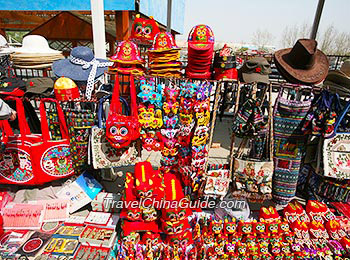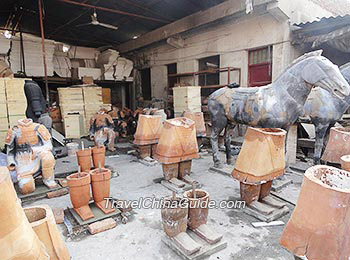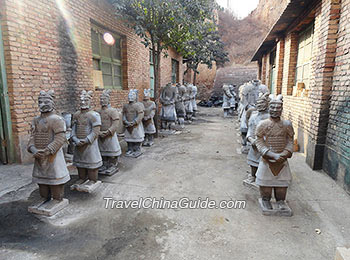Terracotta Army Village
Located about 400 meters (437 yards) east of the front square of the Terracotta Army museum, Xiahe Village has become widely known as the Terracotta Army Village. Consisting of the three teams Xiahe, Xiyang, and Xisun, it was once greatly dependent on agriculture like many other villages in China. With the discovery of the Emperor Qin Shi Huang’s army for his afterlife, the villagers became rich by making tourism souvenirs such as traditional Chinese needlework and replicas of the terracotta warriors. They also offer accommodation and catering services for visitors. Hence, someone joked that the Xiahe villagers are now rich with the “help” of Emperor Qin Si Huang.
The Terracotta Army Village has graceful surroundings and an environment composed of neat streets, lush green trees and flowers. With antique Qin architectural features, the beautiful two storied country houses inside the village are distinctive with their white walls, grey roof tiles, tawny house colonnades, and al-alloy doors & windows. There are three large squares providing outdoor recreation facilities for the farmers. The inhabitants of this heritage village regard two individuals responsible for their newfound wealth, one is the farmer Yang Zhifa who dug up the first terracotta warrior, and the other is the emperor Qin Shi Huang himself who had the terracotta warriors created.
Following its discovery in 1974 huge numbers of tourists come visit the terracotta army and Emperor Qinshihuang's Mausoleum Site Museum. Subsequently, the people of Terracotta Army Village became rich, initially because of the women’s excellent needlework. Traditionally, they made tiger-head shaped slippers and embroidered quilts for newborn babies. They exhibited some of these to the tourists visiting the terracotta army. It was not surprising that the tourists admired the exquisite work and wished to buy some as souvenirs. The tourists did not bargain and were willing to pay the asking prices. Hence, the needlework became a major source of income for the local people.
In order improve their communication with overseas visitors; the villagers attended the English language classes. Some of them were unable to write their own name, but they could speak some simple English to do business with tourists instead of relying upon sign language for their deals.
Producing replicas of the unearthed ceramic figures and horses as well as other historic relics also helped the local economy to flourish. Since the late 1980s, almost 200 workshops have opened, along each side of the shuttle bus route and they mostly manufacture replicate terracotta figures.
The technology for the manufacture of the replicas has improved over the decades. Now too, the factories have a better way of packing the figures by parceling them with plastic foam, so that they will not suffer damage during shipping.
Xiahe Village receives many domestic and overseas guests, and gradually they have developed a farmhouse appreciation project to meet the growth of visitor numbers. This gives visitors the opportunity to enhance their visit to the terracotta site with an experience of the daily life of Chinese rural families.
To attract tourists, they invested nearly ten thousand yuan for road repairs, and more than 80,000 yuan for decorating the roads with trees and flowering plants as well as installing street lamps. In addition, they created a central plaza within the village. Visitors can now taste country style cuisine, see how to make Chinese dumplings and learn about the art of paper cutting. The opportunity to pick pomegranates is yet another of the various aspects of country life offered as part of the project.
 Recommended Tour Itinerary:
Recommended Tour Itinerary:
Terracotta Warriors Tour: One-day to visit Terracotta Warriors and Horses and more
More Xi'an Tours
Pretty Terracotta Army Village in Qin Dynasty Architectural Style
How Did the Villagers Get Rich with the “Help” of Emperor of Qin Shi Huang?
Making Traditional Chinese Needlework Souvenirs
 |
| Needlework Souvenirs |
In order improve their communication with overseas visitors; the villagers attended the English language classes. Some of them were unable to write their own name, but they could speak some simple English to do business with tourists instead of relying upon sign language for their deals.
Producing Replicas of Terracotta Warriors and Horses
The technology for the manufacture of the replicas has improved over the decades. Now too, the factories have a better way of packing the figures by parceling them with plastic foam, so that they will not suffer damage during shipping.
|
|
Running Farmhouse Restaurants and Hotels
To attract tourists, they invested nearly ten thousand yuan for road repairs, and more than 80,000 yuan for decorating the roads with trees and flowering plants as well as installing street lamps. In addition, they created a central plaza within the village. Visitors can now taste country style cuisine, see how to make Chinese dumplings and learn about the art of paper cutting. The opportunity to pick pomegranates is yet another of the various aspects of country life offered as part of the project.
Terracotta Warriors Tour: One-day to visit Terracotta Warriors and Horses and more
More Xi'an Tours
- Last updated on Aug. 14, 2024 by Catherine He -

